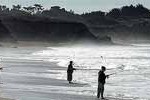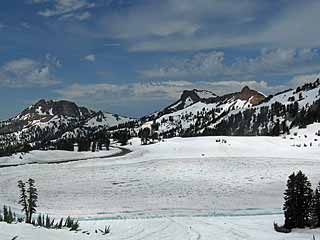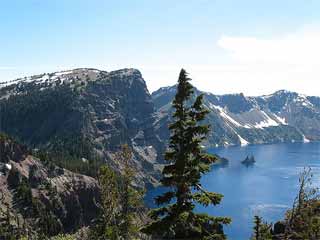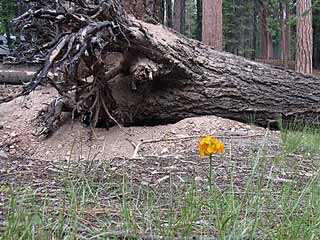
This is a guest post by Karen Ho Fatt, who publishes an outdoor fire pit review site. If you would like to guest post on CampingBlogger, please see the guest posting page for more information.
Most of us are planning to head out to the National Parks this spring season. You will probably be making the most of your trip there; hunting, cooking and fishing are probably on the trailblazing menu. But most of us usually incorporate some kind of photography to document their trips into the great outdoors. But how do you create a more meaningful representation of these spectacular creations of nature?
For those who don’t want to just settle for the run of the mill “snapshots” here are some tips to improving your skills while on holiday.

Frozen Lake Helen in Lassen NP
Capture the Big Scene. This is the trophy photo is what we all try to achieve as photographers, the one that makes a statement; the majestic mountains rising above the clouds with the river running through below. A wide angle lens from 15mmm to 24mm is best to help you achieve that panoramic view.
Get in Closer. Photograph scenes within scenes. Focus on smaller details such as animals in the landscape with the trees as a backdrop.
Carry multiple lenses. Use a 24- 70mm lens for more standard scenes (as it looks to the eye) and a zoom lens in the 70-200mm range will help you get those far away details closer to you. A macro lens will give you a 1:1 view of your subject and will capture intimate details such as bugs on a budding leaf.

Crater Lake NP, in Oregon
Capture the Mood of the place. Getting to your location at sunrise and sunset when the light is golden will impart a different mood to your subject. A side lit mountain is a sight to behold: you will see it alternately glowing in shades of pink, orange or yellow. These magic moments are fleeting so you will have to be quick with the shutter and set up early before the sun rises (before 10 am) or before it sets (after 3pm).
Storms, Rain, Mist and Fog are not your enemies but your friend. These elements are great mood creators and incorporating them will elevate the image to a different level. They will turn the mundane into the extraordinary. And remember to dress in layers for these extreme weather changes you may encounter in the wilderness that you will want to capture.

First signs of spring
Use a Monopod or Tripod. Nature’s fickle weather and the magic moments of sunrise and sunset are often bathed in low light so you will need these tools if you want your pictures looking their best. Otherwise steady yourself against a tree and don’t breathe if you don’t have any one on hand! In addition to the latter you will probably need to use very high ISO in these low light situations and alter these more grainy images with noise software later. The monopod’s added benefit is that it also can double as a walking stick!
Get a GPS. Sure handy if you get lost but you may want to come back to the same location at a different time of day to capture a different mood and look.
Last but not least, know your camera and its limitations. Read your manual and learn what all those buttons were meant to do. As stale and boring as it may be, you don’t want to be fumbling around and not capture that fleeting moment!
These basic principles apply if you have a DSLR camera with interchangeable lenses or a more simple point and shoot camera. Taking photos is a combination of both serendipity and some careful planning. But take note as you will see miles of improvement in your travels into the great outdoors!
See also…

Quality camping site, i can see you have put the work in, well done quality read.
Great pictures and tips! I love taking pictures on my camping and backpacking trips and am always glad to learn something new to improve my photography. Thanks!
Thanks for that very great tips. All those techniques can really help to capture the beauty of every subject you would want to keep.
Great post. I carry a copy of the Kodak Pocket Photoguide in my camera bag as a quick resource for those unique photo opportunities.
Great pictures and tips. Makes me want to go camping!
Great tips. It was actually a camping trip through Washington’s North Cascades last summer that induced me to upgrade to a DSLR. Its worked out brilliantly this year for both camping, motorcycle trips and sailing. A backpack camera bag is a must, I use it all the time.
What an excellent article! I may need to reference it on my site as I am sure that many campers will need to brush up on their photography skills.
These are great tips and ideas! I do a lot of outdoor photography and I often forget some of these along the way. I will be sure to add these back to my list! Thank you.
That’s awsome maybe you will can share whit us the pictures that you made or you will make 🙂
That’s a good idea. Can you share whit us your art? 😡
I would be happy to share some of them with you. Almost all of the photos I used on my carcamping site are my work and I also have my own photography site located at http://www.terikai.com. If I knew how, I would post a couple of them right in this post but I couldn’t figure it out. LOL.
My favorite tip above is about the storms and weather. I think many people stay indoors when the weather is bad and that’s when I love to try and get out but it is very challenging.
Wow wow! Therea are some where awsome pictures that you have made… what are you doing is realy ART! Good JOB!
Thank you for the kind words on my photos!
I wondered if any of you have ever experienced photographing in the cold where it tends to freeze up your shutter on the DSLR?
Yap is very very beutifull you are the artist!
This is nice, the photo make me to feel so nice and full of nature, we need to go camping more whit freiends and family, and we need to protect the nature and the wilde life more!
This are some great ideas. I put together a list of camera tips of my own, however I’m no photographer. I’ll definitely use some of these tips on my next camping trip for sure.
WOW WOW WOW there are some very nice pictures. The most I like is Crater Lake NP, in Oregon the photo is amazing is awsome, but the Frozen Lake Helen in Lassen NP is awsome too, I may ask do you have a pic whit Lake Helen when is not frozen?
Any tips on how to use your camera on a beach. I never do as I worry about sand ruining it.
Author of Tent Reviews
I learned my beach lesson the hard way last year. Make sure you change lenses in a bag and don’t get it near water-cover it with plastic of some kind. Change lenses if possible before you get to the beach!There are raincovers for cameras you can purchase that will help but salt and sand are definitely killers, especially on the pocketbooks. Here is a helpful resource: http://photo.net/medium-format-photography-forum/007Cq4
We have a new camera to bring camping and I’m still trying to figure it out. Thanks for the tips!
Don’t foget the manual and to read it! I find I try some things first then re-read the book in snippets as I go along, sure helps to learning the camera quickly.